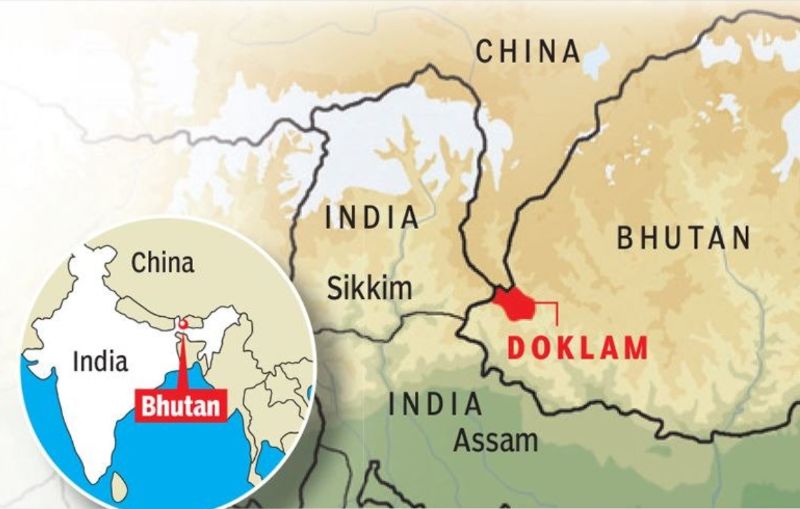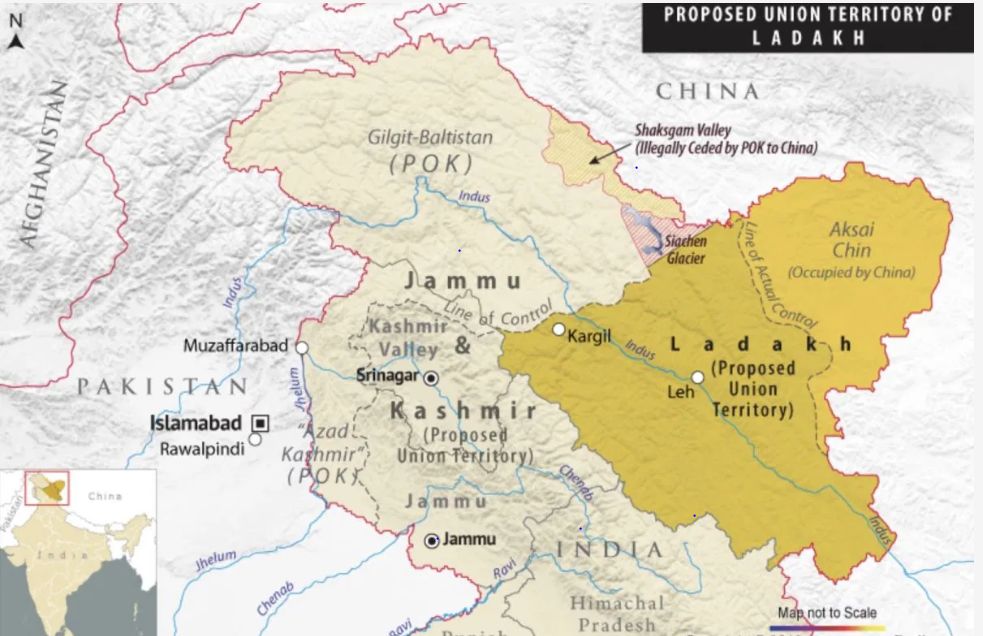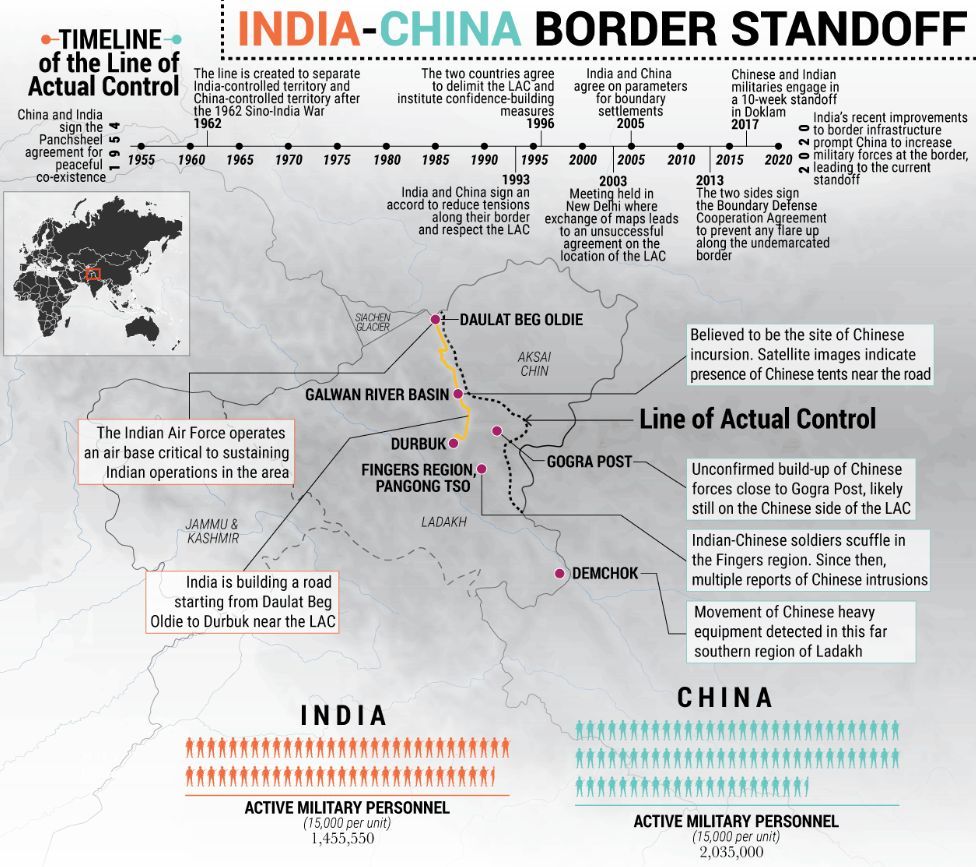By Eric Vandenbroeck 24 May 2020
Update 16
June 2020: China claims
agreement with India to deescalate the situation has been reached. India said the clash arose from "an
attempt by the Chinese side to unilaterally change the status quo" on
the border plus that there were over 40 Chinese casualties.
------------
Recently the
Washington Post including various Indian and Chinese news outlets caused
alarm by asking if India and China could go to war.
This while India and
China step up vigil, in Ladakh and Sikkim sectors of the Line of Actual Control
(LAC), where India and China have deployed additional troops, days after scores
of Indian and Chinese soldiers were involved in a tense
face-off along the India-China boundary.
As described in an earlier article the 1959 war had
more to do with domestic problems in China, including the disastrous Great Leap
Forward campaign launched in the late 1950s which resulted in widespread famine
and sparked opposition within the Communist Party against leader Mao Zedong,
whereby also later India and China did not have a well-defined border, and
troop face-offs are common along its 3,500 km Line of Actual Control (LAC).
Today's
nationalism-driven maneuvers could also be a means for Xi to deflect attention
from his government’s often opaque handling of the Covid-19 crisis.
The Global Times’
recent mention of the 1962 war makes several references to what Beijing seems
to believe is a new US-India alliance against China.
The border can be
broadly divided into three sectors—Western, Middle, and Eastern. The Western
sector, which includes Ladakh, is governed by the Johnson Line, making Aksai
Chin (controlled by China) in Jammu and Kashmir contested territory for India.
The Middle sector,
consisting of Uttarakhand and Himachal, is relatively tranquil. Even map
exchanges between the two countries have taken place, based on a broad
understanding of borders.
In the Eastern Sector
(where Indian controls territory based on the MacMahon
Line), China claims Arunachal Pradesh as part of southern Tibet, while
India contests it. The MacMahon Line was drawn at the tripartite 1913-14 Simla
Convention attended by British India, Tibet, and China; the problem: Tibet is
involved and China is not a signatory to this pact.
Why we should be concerned about today’s China and
India’s Border Skirmishes
At the epicenter of
the growing
crisis is the Doklam plateau, which sits at the
tri-junction of India, China, and Bhutan, near the northeastern Indian state of
Sikkim. In June, the Bhutanese army objected to the Chinese constructing a road
in territory that it says is within its sovereignty.

The two countries,which share the world’s longest unmarked border,
fought a full-fledged war in 1962 and have since engaged in several small
skirmishes. Not since 1975
has a bullet been fired across their shared border. As a result, the theory
that Sino-Indian clashes are flashes in the pan and unlikely to lead to more
extensive fighting has become a widely held consensus. Recent events, however,
suggest that escalations are highly possible. Both sides have substantial, and
growing, military deployments along a mostly disputed border. And for more than
a decade, the People’s Liberation Army (PLA) has been testing India’s military
readiness and political resolve along with several strategic areas. Peace can
no longer be taken for granted.

The most recent
clashes took place earlier this month. On May 5, Indian and Chinese soldiers
clashed near the Pangong Tso lake in Ladakh. It is believed that the skirmish
took place because the PLA had objected to Indian military patrols in the area.
Most of these clashes apparently stem
from differing assessments of the location of the so-called Line of Actual Control,
the de facto international border. And then on May 9, at an altitude of 15,000
feet, in the Naku La region near Tibet, soldiers from
both sides came to blows and threw stones at each other mostly in efforts
to induce the Indian troops to move back from the areas they were patrolling.
No arms were used but several dozen soldiers were injured, including a senior
Indian officer who was required to be airlifted to a hospital.
According to the
Indian government, the Chinese military crossed
into Indian territory 1,025 times between 2016 and 2018. Given that China and
India’s borders remain unmarked, such transgressions are likely rooted in how
Beijing and New Delhi have different perceptions about the extent of their
territories.
After a long period
of relative quiet along the Sino-Indian border, militarized incidents have come
to the fore again. In 2017, when Indian and Chinese troops faced off for two
months in Doklam, an area claimed by both Bhutan and
China, a serious military clash was a distinct possibility. While that
particular crisis abated, it is perhaps instructive to see the standoff not as
an aberration but as part of a new phase in relations between the two
countries. The old phase dates back to 1988, a year after a military skirmish
between India and China in the Sumdorong Chu Valley
in Arunachal Pradesh, when Indian Prime Minister Rajiv Gandhi visited his
counterpart Deng Xiaoping in Beijing to mend ties. The two leaders agreed to
establish a forward-looking relationship even as important issues such as the
border dispute were temporarily set aside. The reason for this pragmatism was
rooted in economic and strategic factors: Both China and India needed a stable
external environment to promote domestic economic development. China was
already a decade into the dramatic economic reforms that Deng had initiated,
while Gandhi’s India had also embarked on a similar path, albeit hesitantly.
The 1988 compromise
between India and China, helped in part by New Delhi’s studious silence on
developments within Tibet, was driven by the fact that the two countries were
near equals on the world stage. According to the World
Bank, India’s gross domestic product was $297 billion compared with China’s
$312 billion that year, while India’s defense spending, at $10.6
billion, was also close to the Chinese allocation of $11.4 billion.
The material balance
of power between China and India has dramatically changed since then. At $13.6
trillion in 2018, China’s GDP is now more than five times India’s $2.7
trillion. Similarly, China spent $261.1 billion on defense expenditure in 2019,
almost four times India’s total of $71.1 billion. While India has risen as an
economy and a global power in the past three decades, its relative strength to
China has in fact greatly declined.
A new economic
dynamic means that the underlying bedrock of the Gandhi-Deng bargain, of
similar means and goals, is fizzling
out. Although it remains unclear when exactly the understanding between New
Delhi and Beijing began to fade, most likely after the 2008 global financial
crisis, China has become far more assertive in its foreign affairs in recent
years, from artificial-island-building activities in the South China Sea to its
muscular diplomacy amid the coronavirus pandemic. Indeed, some scholars have argued
that an impending power transition is underway between China and the United
States, the current global hegemon. While New Delhi has also become a more
assertive player in global politics its rise has not been of much concern to
the United States.
China and India’s
recent border clashes look increasingly worrying in the context of these
changing power dynamics. The Gandhi-Deng bargain paved the way for a number of
border management agreements (including the 1993
and 1996
agreements related to confidence-building measures and the 2005
agreement on the political parameters guiding boundary negotiations). More
recently, high-profile summits between the two countries’ top leaders, in Wuhan and
in Mamallapuram, have played an important role in managing
the overall relationship. However, even as the 1988 deal allowed relative
tranquility along their border and promoted commercial links between China and
India, none of their outstanding issues, including the border dispute, were
actually resolved.
China and India find
themselves in an “extraordinarily
complex relationship,” according to Subrahmanyam Jaishankar, India’s
foreign minister. In addition to the border dispute, some of the core issues in
the Sino-Indian rivalry
include Tibet (the presence of the Dalai Lama, the Tibetan government-in-exile,
and tens of thousands of Tibetan exiles in India), the burgeoning
China-Pakistan partnership, and the two countries’ overlapping spheres of
influence in Asia. These issues have become more salient in the context of the
two countries’ simultaneous
but asymmetric rising power.
China and India’s material
capabilities remain in flux; China continues to outstrip India along most axes
of power even as New Delhi seeks to boost its own capabilities. According to the
World Bank, India recorded higher growth rates than China every year
between 2014 and 2018. While the long-term economic impact of the coronavirus pandemic
remains unclear, India’s smaller economy and marginally faster growth rates
mean that it has the potential to narrow its power gap with China, at least in
the long term. In other words, India is the only major power that is rising
with respect to China, even as China grows faster than other major powers such
as Japan and the United States.
In addition to
accruing power domestically, India is also building strong strategic
partnerships with China’s other rivals, especially the
United States and Japan.
Meanwhile, a rising China has stabilized its northern borders with Russia and
is working to undermine
the United States’ primacy
in the East Asian maritime commons through the modernization of its military
and its push to build islands. This basically leaves only one border issue with
a rival unresolved: namely, the Sino-Indian border. It is hardly surprising
that it is exerting periodic pressure on India along this front, a trend that
is only likely to escalate.
As
reported today the Chinese military is rapidly increasing its troops in
areas around Pangong Tso lake and Galwan Valley along the Line of Actual
Control in Ladakh, sending a strong and clear signal to India that it is not
ready to end its confrontation with the Indian Army anytime soon.
The Chinese side has
reinforced its position in the Galwan Valley by erecting around 100 tents in
the last two weeks apart from bringing in heavy equipment for construction of
bunkers, despite stiff protest by Indian troops. Whereby China, in turn blames
India by
crossing the boundary line in Galwan Valley.

For updates click homepage here